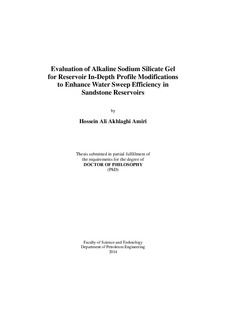Evaluation of Alkaline Sodium Silicate Gel for Reservoir In-Depth Profile Modifications to Enhance Water Sweep Efficiency in Sandstone Reservoirs
Doctoral thesis

View/
Date
2014-03Metadata
Show full item recordCollections
- PhD theses (TN-IPT) [21]
Original version
Evaluation of Alkaline Sodium Silicate Gel for Reservoir In-Depth Profile Modifications to Enhance Water Sweep Efficiency in Sandstone Reservoirs by Hossein Ali Akhlagi Amiri, Stavanger : University of Stavanger, 2014 (PhD thesis UiS, no. 221)Abstract
Alkaline sodium silicate (Na-silicate) is addressed to be applied for in-depth
water conformance control in sandstone reservoirs containing high
permeability layers.
The main factors affecting the gel time, strength and shrinkage in the alkaline
silicate systems are the Na-silicate content, the pH, the presence of divalent
ions and temperature. Divalent ions, e.g., Ca2+ and Mg2+, reduced the gel time
and increased the gel strength and shrinkage. They also caused metal silicate
precipitation at high concentrations. No precipitation formed with low-salinity
water (25-times diluted seawater), which makes it a possible option for preflushing
reservoir in field application.
Temperature accelerated the gel time but the gel strength was shown to be
reduced as temperature increased from 20 to 50 °C. Further increase in the
temperature to 80 °C showed a slight increase of the gel strength. This may be
attributed to increase of silicate solubility at high temperature. High shear
rates, even for a short interval before gelation (which resembles the wellbore
case), accelerated gel time; hence must be considered in field applications. A
simple graphical method was suggested to estimate the combined effects of
different factors on the gel time and strength.
Dynamic adsorption of silicate in sand-packs was considerably lower than the
estimated mono-layer adsorption. It was demonstrated that silicate adsorption
is reversible, and most of the adsorbed mass is desorbed in the post-flush
water. Na-silicate showed water-like injectivity in flooding experiments.
Description
PhD thesis in Petroleum engineering
Has parts
H. A. Akhlaghi Amiri and A. A. Hamouda, 2013: Evaluation of level set and phase field methods in modeling two phase flow with viscosity contrast through dual-permeability porous medium. International Journal of Multiphase flow. 52, 22-34.H. A. Akhlaghi Amiri and A. A. Hamouda, 2014: Pore-scale modeling of non-isothermal two phase flow in 2D porous media: Influences of viscosity, capillarity, wettability and heterogeneity. International Journal of Multiphase flow. 61, 14-27.
A. A. Hamouda and H. A. Akhlaghi Amiri, 2014: Factors affecting alkaline sodium silicate gelation for in-depth reservoir profile modification. Energies. 7 (2), 568-590.
H. A. Akhlaghi Amiri and A. A. Hamouda, 2012: Pore-scale simulation of coupled two-phase flow and heat transfer through dual-permeability porous medium. Presented at 2012 COMSOL Conference, Milan, Italy, October 10-12.
H. A. Akhlaghi Amiri, A. A. Hamouda and A. Roostaei, 2014: Sodium silicate behavior in porous media being applied for in-depth profile modifications
